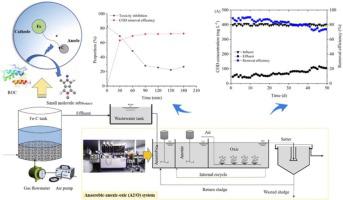Journal of Environmental Chemical Engineering ( IF 7.4 ) Pub Date : 2022-01-19 , DOI: 10.1016/j.jece.2022.107235 Chongsen Duan 1 , Xiao Huang 1 , Jingsi Gao 2 , Yuqi Zhou 1 , Na Chen 2 , Jia Zhu 2

|
For exploring the nitrogen and phosphorus removal performance of iron-carbon (Fe-C) micro-electrolysis pretreatment coupling with anaerobic-anoxic-oxic (A2/O) process, a pilot experiment was constructed and microbial community structure of A2/O process was investigated by high-throughput sequencing. The results showed that Fe-C micro-electrolysis could reduce the toxicity of refractory organic compounds (ROC) and improve wastewater biodegradability. Though sodium dodecyl benzene sulfonate (SDBS) contributed to the accumulation of ammonia nitrogen (NH4+-N) by inhibiting nitrifying process, the chemical oxygen demand (COD), total nitrogen (TN), NH4+-N and total phosphorus (TP) in effluent reached 75.80, 0.65, 0.62, 0.74 mg L−1, respectively, with the addition of 40% Fe-C micro-electrolysis effluent (met the discharged standards of China (GB21900–2008)). High-throughput sequencing results demonstrated that the greatest changes occurred in anaerobic unit, and the dominant microbial genera were Aeromonas, Enterobacter, uncultured_bacterium_c_Gammaproteobacteria, Zoogloea and Acidovorax.











































 京公网安备 11010802027423号
京公网安备 11010802027423号